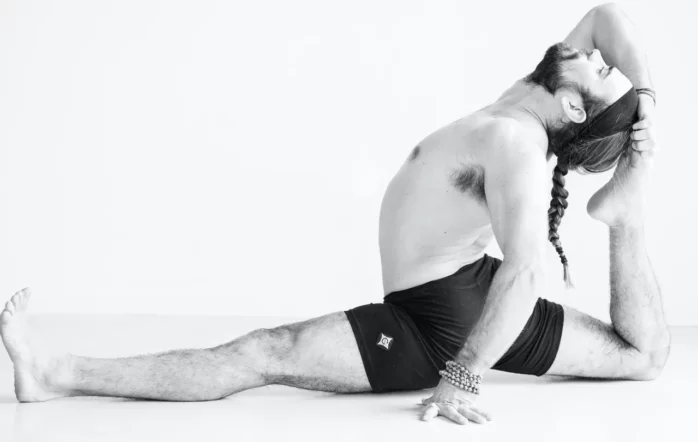Injuries can occur during any physical activity. A pulled muscle happens when the muscle is loaded too fast or is stretched too far with improper alignment or a lack of engagement. A pulled muscle is exactly what it is called. It is a muscle that has pulled away from the bone. This is a result of the stretch reflex contraction, which tightens the connective tissue (golgi tendon organs) around the origin and insertion points of a muscle. When the GTO’s receive a message to tighten up from the central nervous system, then they contract to protect the muscle at its most important areas where it attached to bone. This contraction at the origin and insertion points of the muscle causes the belly of the muscle to then ‘pull’ away at the center. This is because it is impossible to repair a muscle that is torn off of the bone without surgery, however a pulled muscle can be healed within 24 hrs.
I discovered how to heal a pulled hamstring one night at the beginning of an advanced teacher training in Utah. This was a training for teachers that were already certified and were very advanced. We were practicing Hanumansana (full splits) on the first day and I pulled my hamstring after the third or fourth one. This was the second time it had happened to me. The first time it took me 2 years to heal because I didn’t know what I was doing. I had this annoying tingling and weak sensation in my hamstrings all day long. I even developed ‘yogi butt’ where you feel the pull all the way up toward the attachment on the sitting bone (ischial tuberosity). I was determined not to go through that again. I knew I had to re-attach the muscle on the bone, but I was camping out in the forest and didn’t have an ace bandage, KT tape, or a yoga belt. So, I took a pair of my favorite yoga pants from the Girl Skirt Mission and twisted them up like a tight rope. I then wrapped the pants around the belly of my hamstrings like a tourniquet and went to sleep. The next morning when I awoke my hamstrings felt fine and I proceeded to complete the training without any further complications.
My teacher at that time, John Friend, had actually written an article that was published in a medical journal on how to heal a pulled hamstring by DOING Hanumansana. This makes sense in theory, which I will explain, as it is often the case that it is the pose that causes the injury is also the one that will promote healing. This is true if you realize how you incorrectly performed the pose and how it was poor technique and alignment that caused the injury. If you keep repeating the same pose in the same manner, while thinking that will heal you, then that is the definition of insanity. Performing the same action over and over and expecting a different result will drive you crazy and will not heal anything. However, if you recognize the error and correct then, yes, the same pose can heal you. The basic formula is: “weight + alignment =healing.” This means that you load a muscle with weight or resistance and place it in proper alignment on the bone, and then over time it will heal. This will work in Hanumansana for a pulled hamstring, if you support your body weight by placing blocks under the hands, so you can focus on the action in the leg. The muscle must first be re-aligned on the thigh bone. To accomplish this place both hands on the inside in front of you. Tilt the pelvis to the side and arch up like in a back bend. When the thigh bone inner rotates it tracks the three hamstrings onto the bone. Then return to the start position. Hold the arch and slowly let the hips descend. You can repeat the tilt to inner rotate the thigh 2-3 more times before resting. This can promote healing overtime because it is using alignment and body weight to promote the healing.
I’m proposing something much faster that I call “aggressive therapeutics” where you immediately start to rehabilitate the pulled muscle through a non-stop application of wrapping for compression, heating, and massage for 24hrs. I have healed three major pulls in my body by doing this and am writing to help other yogis and athletes out there are struggling to heal a muscle. For this article I would like to address the three most common areas that get pulled: hamstrings, hip flexors (psoas major, iliacus, TFL, pectineus), and the lower back. These areas are most commonly pulled because they bear the most weight through physical activity by linking actions of the upper body and lower body. Since they get loaded the most, they are the most susceptible to pulling away from the bone.
I have already discussed wrapping a hamstring back onto the bone. It is the compression that re-attaches the muscle back on to the bone. It is necessary to know how to wrap the muscle with an ‘inner spiral’ to encourage the fascia and muscle to move in the right direction. Start by taking an official Aceâ bandage (not some cheap Walgreens version) and place it behind the gluteus maximus. Hold one end short and ne long. If it is your left hamstrings that you are wrapping, then your right hand will hold the short end. Pull the bandage straight up, as if you were literally trying to pull your butt straight up from underneath. This creates compression at the origin point of the three hamstrings (semitendinosus, semimembranosus, biceps femoris). Then wrap the long end with your left hand over the top of the thigh and down around the adductors. Then pass the shorter end over the thigh to the outside. Make an X at the belly of the hamstrings, and then it off at the insertion points behind the knee.
Either before or after wrapping add in heat. If you are using a moist heating pad, then sit on it after wrapping. Warning here – most electrical heating pads have instructions not to sit on them due to burning. I have never had any real problems. Keep the temperature moderate to avoid burning the skin. If you are using Tiger Balm, Deep Blue, or Tei Fu cream then it is best to apply before the wrapping if possible. Heat increases circulation. It is the blood that carries vital nutrients to the muscle to repair it. Ice does not promote healing which is a popular misconception. Ice can prevent further swelling but it won’t drain fluid from a joint. To do drain excessive fluid from a joint you have to pump the muscles around the joint by contracting and releasing. If a damaged muscle swells up, then it is imperative that you go to the emergency room immediately to seek treatment. Ice is really only good for numbing pain. Your nerves can only carry one signal to the CNS, which is either pain, hot, or cold. So, if you are in pain, then ice is good for numbing, but it won’t promote healing. If you want to play it safe then you can do 20-min on of ice, then 20-min of heat, and then 20-min off. If it is in the morning, then end the cycle with heat. If it is in the evening, then end with ice to seal the circulation within the muscle.
The next Aggressive Therapeutic technique to apply is massage. If you are massaging a pulled hamstring, then there is no substitute for the Vyperâ vibrating massage foam roller. I actually carry it with me everywhere I go. The other day I was driving around Miami and my hamstring started to talk to me. I pulled over into an empty parking lot and got out my Vyper. I sat on it and rolled out my hamstrings at a high intensity vibration which increases circulation and shuts down any firing of the GTO’s. Within 3 minutes I was all good and got back in the car. The action of sitting on the roller widens the muscle and the body weight pushes it onto the bone. When the muscle is on the bone then any synaptic firing inside the muscle is silenced. Three minutes on a Vyper is equivalent to one hour on a regular foam roller.
The hip flexors can be treated the same way. I had an annoying pulled psoas that kept bothering me until I got serious about treating it. I wrapped it off with an Ace bandage by making the X in front of the hip and went to sleep. I woke up with it completely healed. Of course, heat and massage will also help. The hip flexors are difficult to get into. To massage yourself place one hand on the injured hip and wrap the fingers over the iliac crest. Bend over and push your fingers deep inside and massage towards the inside of the hip bone.
One day in class I pulled a muscle in my lower back just by pointing to a student, and in that moment, I realized what people were referring to by “throwing out there back.”. I had an excess of tension from sitting at my desk and it finally pulled the muscle away from the bone. It almost took my breath away and I could barely stand upright. I realized I couldn’t stand there in pain and continue to teach, so I started to practice with the class. I did deep and intense backbends to get the muscle back toward the bone including drop-backs and tik-toks (viparita chakrasana). It was painful at first, but the circulation increased, and it started to improve. After class I immediately got a massage and then went up to my apartment and laid on my belly with heat on my lower back. This undoubtedly saved me. If I had done nothing, I would have ended up in bed for 6 weeks or with a back brace. When a muscle pulls it loses circulation and then the muscle tightens up around the injury to protect it, which further limits circulation. Therefore, it is circulation through wrapping, heating, and massage that heals a muscle. If you do it aggressively then you can heal any pulled muscle in 24hrs.
By Ken “Anand” von Roenn III



